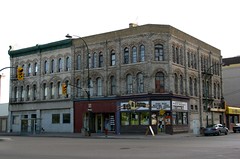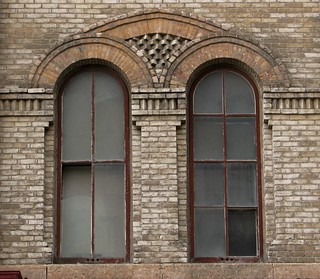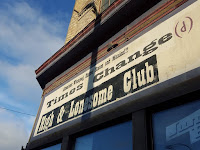Place: Fortune Block
Address: 232 Main Street
Architect: Willmot and Stewart
Contractor: Grant And Geeley
Built: 1882-83
February 7, 1883, Manitoba Free Press
Winnipeg real estate developer Mark Fortune financed the construction of the Fortune Block. Construction began in 1882 but by the time it opened in January 1883, he had already sold it to local businessman Alexander "Sandy" Macdonald.
MacDonald had the near twin Macdonald Block constructed immediately to the south, (the lighter coloured building in the photo above), from which he ran his wholesale grocery business. He left the neighbouring Fortune Block intact, even retaining its original name.
MacDonald had the near twin Macdonald Block constructed immediately to the south, (the lighter coloured building in the photo above), from which he ran his wholesale grocery business. He left the neighbouring Fortune Block intact, even retaining its original name.
Most of the early main floor retail tenants lasted just a couple of years before closing or moving on. An early tenant, and relatively long lasting one, was Holman Brothers' butcher shop (1880's - 1900). It was usually paired with a dry goods or confectionery store.
In the 1920's the main floor of the Fortune Block became home to a series of restaurants, including Murphy's Café (1920's), Winnipeg Electric Lunch (1930's) and the Tourist Café (1940's - 52). It then went industrial, as home to a car parts shop, then a floor covering contractor.
The upper floor businesses were a revolving door of dressmakers, tailors, financial agents, personnel agencies and real estate firms, including Mark Fortune's for a few years.
Lillian graduated from Michigan State University medical school in 1882 specializing in midwifery and children's diseases. When she returned to Winnipeg, she set up an office in the Fortune Block. Her mother graduated from the same school in 1883 and joined her daughter in practice.
In 1884 the two moved to a new location further north on Main Street. Amelia went on to be as well known for her political activism as her medical practice.
January 24, 1899, Winnipeg Free Press
In October 22, 1888 the "Manitoba Institution for the Education of the Deaf and Dumb", forerunner to the Manitoba School for the Deaf, was opened in suite 1.
It was estimated that there were 80 deaf and mute children in the province. Those that could afford it sent their children to a school in Belleville, Ontario. For most kids though, they received little or no education at all. After years of lobbying by parents and education advocates, the province provided some funding for a temporary school until a formal institute could be formed.
Classes began with eight students under the leadership of an American teacher and deaf education advocate John Calvin Watson who was soon joined by Duncan McDermid.
In late 1889 the school moved to another temporary space in the Land Titles Building and then to its first permanent home at Sherbrook and Portage in 1890.
Another organization that spent its formative years here was the Winnipeg Development and Industrial Bureau.
The bureau was created in 1907 by a committee of the city's leading businessmen to promote industrial development in Winnipeg. In February 1907 they rented an office at the Fortune Block and began publishing a monthly bulletin that would be distributed across North America to provide updates on new developments in the city and extolling factors like its cheap hydro rates and the region's vast transportation infrastructure.
In 1911 the bureau relocated to their own home, the Industrial Bureau Exhibition Building at Main Street and Water Avenue.
The longest lasting of the upstairs businesses was likely the high-end hat shop of Florence Whitlock, which operated from suite 3 from at least 1908 until 1946.
Born in San Francisco, Whitlock lived in England before coming to Winnipeg around 1902 with her British-born husband, Walter, and four year-old son, George. The family soon settled at suite 7 of the Fortune Block.
Whitlock often travelled to Eastern Canada to bring back the latest lines and styles for her clients. She also offered an alteration service for old hats and fur pieces.
When she closed her shop in 1946 at the age of 79, Florence and Walter still lived in Suite 7. She died the following year.
It was estimated that there were 80 deaf and mute children in the province. Those that could afford it sent their children to a school in Belleville, Ontario. For most kids though, they received little or no education at all. After years of lobbying by parents and education advocates, the province provided some funding for a temporary school until a formal institute could be formed.
Classes began with eight students under the leadership of an American teacher and deaf education advocate John Calvin Watson who was soon joined by Duncan McDermid.
In late 1889 the school moved to another temporary space in the Land Titles Building and then to its first permanent home at Sherbrook and Portage in 1890.
Another organization that spent its formative years here was the Winnipeg Development and Industrial Bureau.
The bureau was created in 1907 by a committee of the city's leading businessmen to promote industrial development in Winnipeg. In February 1907 they rented an office at the Fortune Block and began publishing a monthly bulletin that would be distributed across North America to provide updates on new developments in the city and extolling factors like its cheap hydro rates and the region's vast transportation infrastructure.
The longest lasting of the upstairs businesses was likely the high-end hat shop of Florence Whitlock, which operated from suite 3 from at least 1908 until 1946.
Born in San Francisco, Whitlock lived in England before coming to Winnipeg around 1902 with her British-born husband, Walter, and four year-old son, George. The family soon settled at suite 7 of the Fortune Block.
Whitlock often travelled to Eastern Canada to bring back the latest lines and styles for her clients. She also offered an alteration service for old hats and fur pieces.
When she closed her shop in 1946 at the age of 79, Florence and Walter still lived in Suite 7. She died the following year.
Private Thomas Cronely
As time went by, the number of offices appear to declined in favour of residences. In later decades it seems that some of the suites were divided to create more living units. By the late 1970s residential ads for the building disappear from the classifieds sections of the papers.
One of the hundreds of former residents of the Fortune Block was bricklayer Thomas Cronely.
After he enlisted to fight in World War I, his family, wife Ina and five children, relocated to suite 5 of the Fortune Block. On October 9, 1916, during heavy fighting, he went missing on the battlefield. The following July was declared killed in action. His body was never found.
Howard McDonald, whose wife moved into the Fortune Block after he enlisted, was wounded twice in action but survived.
After he enlisted to fight in World War I, his family, wife Ina and five children, relocated to suite 5 of the Fortune Block. On October 9, 1916, during heavy fighting, he went missing on the battlefield. The following July was declared killed in action. His body was never found.
Howard McDonald, whose wife moved into the Fortune Block after he enlisted, was wounded twice in action but survived.
April 1926 ad
He was a co-founder of the Manitoba Free Press, president of the Winnipeg Tribune publishing company, and a board member, later a president, of the Great West Life Assurance Company. In 1892 he served a term as the city's mayor.
Through the 1890s his A. Macdonald & Co. amassed a wholesale, transportation and retail network, including the nearly 50-outlet P & B grocery store chain, that served all of Western Canada. (In 1914 the interests were brought together under the name Macdonalds Consolidated, a company which still exists today.)
The business relocated to larger premises on Pacific Avenue in 1902 and the Main Street properties were sold for $30,000. Mark Fortune acted as the sales agent.
Sadly, Macdonald's personal life was not as successful. When he died in August 1928 he was predeceased by his wife and four sons. Only a daughter survived him.
The board of Macdonalds Consolidated almost immediately sold off the retail wing of the business and about a year later sold the remainder of the company to Safeway.
Commercial Hotel, Fortune Block ca 1926 (Source - p 51)
It was hotelier Samuel Spence who purchase the buildings in 1902. he converted the Macdonald portion into the Commercial Hotel and left the Fortune Block as a mixed use building.
With the upper floors closed for decades, the building is best known today for a long-time main floor tenant.
"Times Change Café" is first mentioned in the Winnipeg Free Press on May 27, 1988. Food critic Marion Warhaft gave chef Richard Barrett and Bev Banks top marks for the specialty of the house: seafood. Barrett had owned a restaurant on Vancouver Island before coming to Winnipeg.
"Times Change Café" is first mentioned in the Winnipeg Free Press on May 27, 1988. Food critic Marion Warhaft gave chef Richard Barrett and Bev Banks top marks for the specialty of the house: seafood. Barrett had owned a restaurant on Vancouver Island before coming to Winnipeg.
She noted in her review that the café hosted live entertainment on weekends after 10 p.m..
A customer, then bartender, then manager of the café was John Scoles. He eventually bought the business and reopened it in January 2001 as the Times Change(d) High and Lonesome Club with live music as its main focus.
In June 2012 it was announced that the long-time building owner, who had not invested in maintenance of the structure for a period of many years, sold it. This led to speculation that it would be torn down, likely with the rest of the ca. 1880s buildings on the block, to offer a large parcel of land suitable for redevelopment.
The situation became more dire when the Fortune Block's new owner and the separate owner of the adjoining MacDonald Block and Winnipeg Hotel opposed the transfer of the three buildings to the city's new List of Historic Resources, noting that a hotel developer had expressed interest in the land should the buildings be demolished.
The city upheld the historic designation of the buildings. Local businessman John Pollard has since purchased the Fortune Block and has vowed to renovate all three stories.
The situation became more dire when the Fortune Block's new owner and the separate owner of the adjoining MacDonald Block and Winnipeg Hotel opposed the transfer of the three buildings to the city's new List of Historic Resources, noting that a hotel developer had expressed interest in the land should the buildings be demolished.
The city upheld the historic designation of the buildings. Local businessman John Pollard has since purchased the Fortune Block and has vowed to renovate all three stories.
Related:
The Year Past (2006) Historic Buildings Committee (pp 16 - 19)
232 Main Street Historic Buildings Committee Overview
My Flickr album of the Fortune Block
Media:
Developer shares vision for the Fortune Block Winnipeg Sun Apr 2016
Fortune Block saved by heritage designation Winnipeg Sun Jan 2016
The Year Past (2006) Historic Buildings Committee (pp 16 - 19)
232 Main Street Historic Buildings Committee Overview
My Flickr album of the Fortune Block
Media:
Developer shares vision for the Fortune Block Winnipeg Sun Apr 2016
Fortune Block saved by heritage designation Winnipeg Sun Jan 2016
Another downtown icon falls? Winnipeg Free Press, June 2012
Fortune Block to go way of Eaton Centre? RAG Review
Times Change(d) threatened with closure CBC, June 2012
Fortune Block to go way of Eaton Centre? RAG Review
Times Change(d) threatened with closure CBC, June 2012

















No comments:
Post a Comment